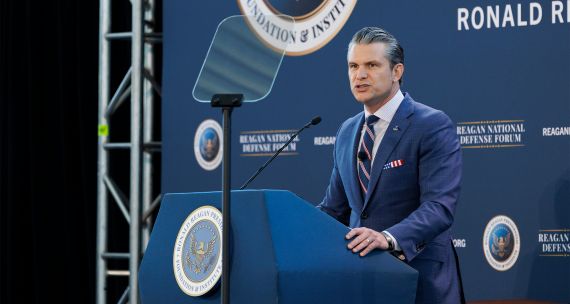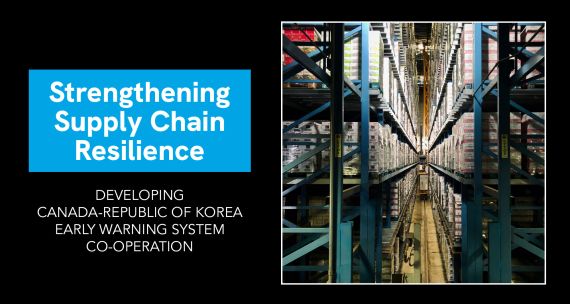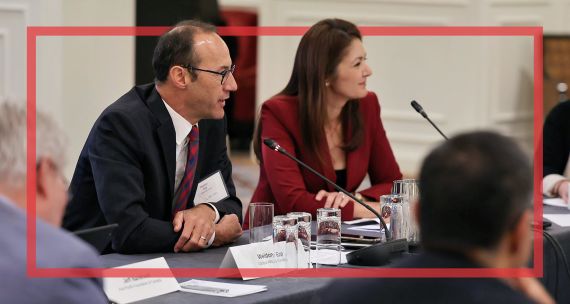Canada’s Indo-Pacific Strategy (IPS) has passed the crucial three-year mark. On balance, the record thus far has been positive: Canada is more present, more visible, and more plugged into regional networks than at any time in recent memory. New offices have opened, ministerial and prime-ministerial travel has become routine, Team Canada trade missions are drawing large delegations, and the Canadian Armed Forces now operates in the region at a sustained tempo.
These are real shifts, and they will pay dividends for Canada’s economic resilience and security in the world’s most pivotal region. At the same time, however, the IPS has run up against familiar Canadian constraints — conceptual, institutional, and resourcing — that limit its impact. Three years on, the task is to make sure that we are translating our presence in the Indo-Pacific into tangible benefits. We do that by moving from a long list of activities to a sharper set of aims, priorities, and partnerships that serve Canada’s national interests in an increasingly fraught strategic environment.
The world of 2025 looks very different from when Canada launched the strategy in 2022. We are living through accelerated great-power competition, sharper economic fragmentation, and intensified grey-zone pressures in cyberspace, maritime domains, and supply chains. The COVID-19 pandemic hangover has given way to geopolitical shocks — from wars in Europe and the Middle East to shifting alignments in Asia — all of which we must account for as we assess the IPS and ensure it is fit for purpose now.
What has worked: presence, profile, and participation
First, the IPS has undeniably increased Canada’s footprint. This includes:
- Trade and financing platforms. Export Development Canada opened new offices in Jakarta, Seoul, Tokyo, Ho Chi Minh City, Manila, and Bangkok, augmenting the services it provides for Canadian firms in critical markets and complementing existing points of presence across the region.
- Sectoral footholds. Canada’s first Indo-Pacific Agriculture and Agri-Food Office officially opened in Manila in February 2024. BlackBerry’s Cybersecurity Center of Excellence in Malaysia, which opened in March 2024, is a concrete example of aligning Canadian capability with partner demand for cyber resilience and skills development — an IPS priority that resonates widely across all of Southeast Asia’s digitalizing economies.
- Regional representation. Ottawa has also appointed an Indo-Pacific Trade Representative and, by year two of the IPS, expanded diplomatic staffing, including a regional cyber attaché network and additional defence advisers.
Second, Canada’s political-level engagement has grown. In 2023 and 2024, multiple prime ministerial and ministerial trips signalled greater senior-level attention — something our partners noticed. Team Canada trade missions — large, multi-sector delegations designed to accelerate commercial activity — launched in Singapore in early 2023, followed by Japan later that year, and with subsequent missions across Southeast Asia. These missions amplify Canadian presence and lead to real results for Canadian firms.
Diplomatically, this engagement helped Canada and ASEAN elevate their ties to a Strategic Partnership in September 2023 — an umbrella under which we can foster even more targeted sectoral co-operation.
Third, there has been an amplification of our security presence. Under Operation HORIZON, Canada now deploys three Royal Canadian Navy warships annually to the Indo-Pacific, participates in multilateral exercises, and synchronizes with partners on maritime security — a tangible signal of the seriousness of our commitment.
Finally, the C$2.3-billion IPS funding envelope has enabled early wins on practical issues. One example is the deployment of Canada’s Dark Vessel Detection (DVD) program in support of Philippine maritime enforcement — near-real-time satellite tracking that helps authorities counter illegal, unreported, and unregulated fishing and improve maritime domain awareness. This is the kind of niche contribution that partners both need and remember.
Together, these elements — new outposts, senior visits and missions, sustained naval presence, and funding for tools that help solve partners’ problems — have raised Canada’s profile and increased its regional participation. They also build on the perception of Canada as a constructive, values-aware, and partnership-oriented actor.
Where impact lags: moving from ‘a strategy’ to strategy
Notwithstanding these real gains, the IPS has struggled to provide strategic clarity. The document is important, useful, and comprehensive but it does not directly answer the core questions that any strategy should answer: what, exactly, is Canada trying to achieve in the Indo-Pacific — and how will we leverage our resources and partnerships to get there? The five objectives are all valid and mutually reinforcing but the linkages between the ends and the means still need clarification and definition.
Specifically, three structural challenges stand out:
1. Ends and prioritizations. The IPS bundles together nearly everything Ottawa wants to do in the Indo-Pacific. That made sense for an inaugural, whole-of-government effort. But three years on, Canada needs a tighter, more focused articulation of the national-interest outcomes it is hoping to achieve (e.g. X per cent of non-U.S. export growth from Indo-Pacific markets; Y maritime security capacity delivered with partner A/B/C; Z number of strategic sectors that are de-risked through closer co-operation with allies’ value-chains), with explicit trade-offs and sequencing. Without prioritization, we run the risk that activity becomes an end in itself.
2. India and China chapters. The IPS’s treatment of India was already somewhat thin, and the diplomatic crisis post-September 2023 rendered it largely moot. That gap matters because any serious Indo-Pacific policy must account for India’s scale, growth, and geopolitical weight, albeit with eyes wide open about constraints and friction points. On China, the IPS rightly highlighted deterrence, de-risking, and the need to constrain harmful PRC behaviours. But that framing proved ill-suited for parts of Southeast Asia, where partners are wary of polarizing narratives even as they hedge against risk; they welcome Canadian capacity but prefer that it be delivered through affirmative agendas (e.g. infrastructure, climate, skills, and digital) rather than “China-centric” language. Our messaging needs to be partner-centric and focused on problem-solving, while acknowledging core security concerns.
3. Whole-of-foreign-policy alignment. In the absence of an updated foreign policy that defines Canadian national interests and risk tolerance, and what levels of resources we will devote to different theatres, regional strategies will be partial. The IPS must be integrated with Canada’s Arctic posture and our Euro-Atlantic engagement. Only then will it reflect the real linkages among North Pacific, North Atlantic, and circumpolar security and supply-chain dynamics.
Context matters here. In a major foreign-policy address in New York City on September 23 of this year, Canadian Prime Minister Mark Carney underscored that the three main assumptions that shaped Canadian statecraft for decades — a rules-based order that broadly worked for us, collective security through NATO plus the U.S., and oceans as protective moats — can no longer be taken for granted.
In short, Canada now feels “less secure and more alone.” The required response is more statecraft capacity, diversified partnerships, and greater investments in diplomacy and defence. The IPS is a natural instrument for acting on that diagnosis, but only if we sharpen its focus.
Revision, not reinvention: three shifts for the next phase
1. Make economic resilience the organizing logic.
Canada’s core Indo-Pacific economic objective should be diversification with depth: that is, not just more markets, but more resilient market positions in strategic sectors (e.g. agri-food, critical minerals and clean tech manufacturing, life sciences, and digital).
Concretely, this means that we:
- Treat the Comprehensive and Progressive Agreement for Trans-Pacific Partnership (CPTPP) as a platform to build scale and sophistication in priority markets (e.g. Japan, Vietnam, and Singapore) and create deliberate linkages between the CPTPP and the Canada-EU Comprehensive Economic and Trade Agreement (e.g. dual-market supply chains with Europe in batteries, small modular reactors, hydrogen, and agri-food), so firms can arbitrage standards and logistics across both agreements.
- Use our newly established footholds — an Agri-Food Office in Manila, Export Development Canada’s offices in Jakarta and Seoul, and Canada’s Indo-Pacific Trade Representative — for multi-year campaigns to lower specific barriers (e.g. sanitary/phytosanitary, procurement access, data localization), with measurable targets for every sector.
- Expand Team Canada missions but equip them with vehicles that support follow-through: in-market account-manager teams and pooled legal/compliance support for small and medium enterprises, for example. Ottawa’s own updates show these missions can be catalytic; the issue is continuity of engagement and converting preliminary gains into more lasting results.
2. Anchor our engagement in strategic partnerships — not just presence.
Canada should identify a short list of anchor partners where interests, trust, and political will are strong and where we can make distinctive contributions. This might include Australia, Japan, New Zealand, the Philippines, South Korea, and Taiwan with issue-specific coalitions (e.g. maritime security with the Philippines, Taiwan and Japan; semiconductor and battery value-chains with South Korea, Taiwan, and Japan; cyber capacity with Singapore and Malaysia). These “clubs” should be designed for action, not just dialogue. The ASEAN-Canada Strategic Partnership should be leveraged as the diplomatic frame, with delivery of results happening through focused and highly ambitious plurilateral groupings with willing member states.
3. Deliver hard, smartly scoped security value.
Sustaining Operation HORIZON’s three-ship cadence is important, but Canada’s comparative advantage is in specialized capabilities in which it punches above its weight: maritime domain awareness, dark-vessel detection, cyber-forensics and attribution, training in explosive ordnance disposal, among others. We should institutionalize these as standing offers to our partners, including Indonesia, Japan, the Philippines, South Korea, Taiwan, and selected Pacific Island states, and tie these offerings to joint exercises and information-sharing protocols.
Mindset and muscle: build Canadians’ Asia competence and strengthen civic ties across the Pacific
Policy only travels at the speed of people. Asia competence — language, regulatory fluency, sector expertise — needs to become a more ingrained Canadian habit. That means:
- Expanding in-market postings and rotational opportunities, not just for diplomats, but also for regulators, procurement officers, and technical standards experts.
- Backing civil-society connectivity with initiatives such as researcher exchanges, sister-city partnerships, media collaborations, and other programs to deepen trust and understanding at levels that complement the government-to-government level.
- Investing in talent pipelines so Canadians gain an understanding of the political economy of Asia from the inside — and so partners see Canada as a long-term, reliable participant, not an occasional visitor.
Reframing development and climate chapters to fit today’s reality
The IPS chapters on development and the environment can be reframed — without abandoning principles — to better support Canada’s economic and security goals. To do this, we must:
- Align our overseas development assistance tools with our geo-economic objectives. Canada doesn’t have the luxury of offering purely untied, multilateral aid if it wants to shape outcomes in a more transactional era. This does not mean politicizing aid or sacrificing quality; it does mean, however, prioritizing bilateral and co-financed programs (as opposed to mostly multilateral programs) that advance shared objectives such as resilient infrastructure, energy transition, and food systems, as well as opening up space for Canadian expertise and standards. Ottawa is already leaning into this with targeted green-infrastructure initiatives and sector partnerships; the next step is scale and focus.
- Connect climate action to economic opportunities. Use climate finance projects (e.g. transmission upgrades, distributed renewables, port decarbonization) where Canadian technology and services can compete — especially in Indonesia, the Philippines, and Vietnam. EDC’s emerging partnerships are a good starting point.
- Sharpen our soft-power tools. Programs such as Dark Vessel Detection show how Canadian technology can quietly deliver public goods at sea while also reinforcing the rules. Package these with training, legal assistance, and data-sharing to build long-term capacity.
Implementation: turn activity into advantage
To convert momentum into durable advantage, the following could be considered:
- Name the outcomes. Publish a short list of five outcome targets for 2026–30 (e.g. non-U.S. export growth from Indo-Pacific markets; share of Canadian procurement won by Indo-Pacific partners in allied supply chains; maritime security effects delivered; students retained as skilled workers; number of joint standards initiatives concluded). Tie each to a lead department and a budget line.
- Choose anchors and design ‘minilateral’ platforms. For each anchor partner (Australia, Japan, New Zealand, Philippines, and South Korea), draft three-year compacts with six to eight deliverables each, focused, for example, on security, trade, and talent. Make these deliverables public and modest in number and track progress on a quarterly basis.
- Be specific about resourcing. Review and reset baseline IPS funding in light of demand signals. The original C$2.3 billion over five years was a meaningful down payment; the next phase may require a mix of re-prioritization and new appropriations to scale what works (e.g. cyber, maritime domain awareness, and project preparation facilities).
- Link theatres. Build practical North Pacific–Nordic and CPTPP–CETA bridges, aligning shipping, energy, trade and data routes.
- Measure conversion, not just attendance. For trade missions and senior visits, publish conversion metrics (e.g. deals closed, regulatory barriers removed, pilots launched) within six months of each trip.
Conclusion: the next turn
Three years in, Canada has expanded its presence in the Indo-Pacific — and that is no small feat.
But presence is a means, not an end. The world has shifted under our feet; assumptions that once underpinned Canadian foreign policy are now contested. In this environment, a revised and reprioritized IPS — nested within a clear national foreign policy, geared to economic resilience and hard-edged partnership, and powered by real Asia competence — can help Canada convert its activity into real advantage.
The goal for the next three years is simple to articulate but hard to do: become a consequential partner in the Indo-Pacific, one that shows up, solves problems, and helps shape outcomes that matter for Canadians’ security and prosperity at home.
Canada’s Indo-Pacific Strategy (2022) included funding over five years for the establishment of an APF Canada office in the region and for new programs and initiatives in support of the IPS.





